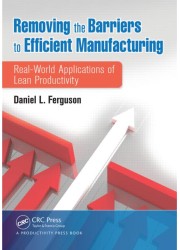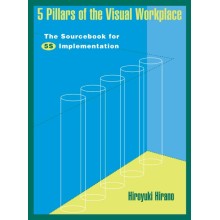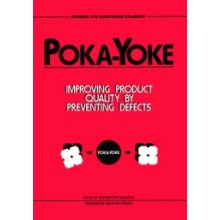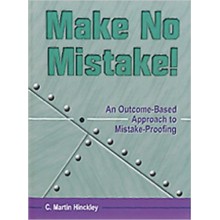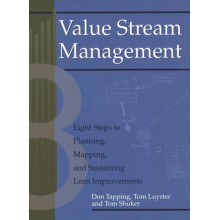Removing the Barriers to Efficient Manufacturing: Real-World Applications of Lean Productivity
ISBN: 9781466555518
Author: Daniel L. Ferguson
Dispatch Time: 2 - 3 Days
Quantity:
-
Add to Compare
Features
- Examines Deming’s 14 Points in a new way—moving from theoretical to real-life application
- Educates managers on the real financial losses associated with variability
- Details practical day-to-day activities that are essential for long-term success
- Explains how to eliminate the barriers that keep people from taking pride in their work
Summary
W. Edwards Deming’s central premise was that improvements in product quality would increase productivity, improve competitive position, and help ensure long-term survival. Point 12 of his landmark 14 Points for Management says that management’s job is to remove the barriers that keep people from taking pride in their work. That’s exactly what this book is about.
Shedding new light on Deming’s 14 Points, Removing the Barriers to Efficient Manufacturing: Real-World Applications of Lean Productivity outlines time-tested organizational structures and methods to help you reduce variability and deliver high-quality products consistently. It describes the financial losses that can occur as a result of variability and details the specific activities management must engage in to avoid these losses and ensure long-term success.
Instead of taking you on a "random walk," the book supplies each manufacturing group in your organization with straightforward directions for creating a smooth-running facility with reduced variability. It includes "work assignments" in each chapter that, if completed in the order presented, will guide you through the creation of the Model Vision for your manufacturing facility. It also:
- Covers key topics on working with people, including training and retraining
- Supplies pointers for working with unions
- Considers Single Minute Exchange of Die (SMED)
- Describes how to put it all together with action plans
The book includes a write up on Deming’s famous Red Bead Experiment as well as an introduction to statistical process control techniques in the appendices. Filled with real-world examples and a case study to illustrate essential concepts, the book arms you with the insight and common-sense approaches required to build on Deming’s fundamental principles and consistently deliver high-quality products that instill a sense of pride in your workforce
Table of Contents
Deming Got it Right
Introduction
Point 1: Management Must Have "Constancy of Purpose" to Stay in Business
Point 2: Adopt the New Philosophy
Point 3: Cease Dependence on Mass Inspection
Point 4: Stop Doing Business with the Low Bidder
Point 5: Find Problems
Point 6: Institute Modern Training Methods
Point 7: Institute Modern Methods of Supervision
Point 8: Drive Out Fear
Point 9: Break Down Barriers between Departments
Point 10: Eliminate Goals, Posters, and Slogans Directed at Workers to Do More
Point 11: Eliminate Numerical Quotas
Point 12: Remove the Barriers that Keep People from Taking Pride in Their Work
Point 13: Institute Vigorous Education and Retraining
Point 14: Top Management Must "Push" (Measure and Report)
Every Day on the Above 13 Points
The Vision
Reducing Variability Is the Key
Removing Barriers in the Workplace
Introduction
Order and Cleanliness
Getting Started
Ergonomics Are Economical
Employee Facilities Show You Care (or Not)
Making Safety Equal to Everything Else
Establishing Minimum Standards
Other Safety Requirements
Summary
Removing the Equipment Reliability Barrier with Effective Maintenance
Introduction
Preventive Maintenance
Predictive Maintenance
Vibration Analysis
Dynamic Balancing
Laser Alignment
Ultrasonic Leak Detection
Infrared Imaging
Motor Analysis
Oil Analysis
PdM Summary
Total Productive Maintenance
The Maintenance Process
Work Orders
Maintenance Planning
Work Order Scheduling and Priorities
Work Order Completion: Getting the Feedback
Maintenance History
Spare Parts Management: Keeping Parts Visible
Stores Inventory Benchmarks
Computerized Maintenance Management System
The Human Factor
Maintenance Performance Benchmarks
Putting It All Together
Removing the Process Variability Barrier with Automatic Control Systems
Introduction
Getting Started
A Few Real-Life Examples
Conclusion
Removing the Product Variability Barrier with Statistical Process Controls
Introduction
Sampled Data versus Continuous Monitoring
The Tools
Prework
Getting Started
A Word of Caution about Sampling
SPC Tool 1: X-Bar and R Charts
SPC Tool 2: Histogram
SPC Tool 3: Pareto Diagram
SPC Tool 4: Control Charts
SPC Tool 5: Fishbone Diagrams
SPC Tool 6: Flow Chart
The X-Bar and Sigma Charting Marches On
Advanced SPC Tools for Digging Deeper
SPC Tool 7: Process Capability Study
SPC Tool 8: Designed Experiments
SPC Tool 9: Scatter Diagram
Summary
Removing the Raw Material Quality Barrier
Introduction
SMED (Single Minute Exchange of Die)
Introduction
The Vision
Getting Started
Step 1: Render the Process Safe
Step 2: Clean the Process
Step 3: Change Machine Settings
Step 4: Changing Components
Step 5: Changing Out Raw Materials and Supplies
Step 6: Additional Sampling
Step 7: Final Adjustments and Centerlining
The SMED Process
Back to the Vision
Summary
The Process Control Manual
Introduction
Products Produced
Product Specifications
Process Description
Process Diagrams
Raw Materials Used
Authorized Operating Supplies
Detailed Operating Procedures
SMED Procedures
Process Reading Sheet
Required Tools
General Safety Procedures
Locking and Tagging Procedures
Housekeeping Checklist
Statistical Process Control
Product Sampling
Product Evaluation
Control Charting
Definition of "In Statistical Control"
Real Purpose of Control Charts
Back to the Process Control Manual
Product Attributes
Summary
Training and Retraining
Introduction
Assessing Basic Skills
The Training Begins
Verification of Training
Retraining
Annual Recertification
Summary
Selected Topics on Working with People
Introduction
Topic 1: Driving out Fear
Topic 2: Promotions (No Good Deed Goes Unpunished)
The Selection Process
After the Promotion
Topic 3: Pay Systems
Pay According to Job Position
Single Pay Rate
Motivating Employees with Pay (Not)
Topic 4: Customer Service
Topic 6: Uplifting Performance Reviews
Topic 7: Your Employees Do Not Have to Be Superstars
Topic 8: Nonpunitive Discipline—The Last Resort
Coaching Session with Informal Note to File
Second Coaching Session with Official Note to File
One Day on Paid Leave for Employee to Develop Action Plan
When All Else Fails: Termination
Conclusion
Closing Comments
Some Pointers on Working with Unions
Organizing for Success
Introduction
The Interdisciplinary Team Concept
The Multidisciplinary Team Concept
The Three Manufacturing Functions
Function 1: Operations
Operations Managers
Operations Crew Leaders
Operators
Function 2: Process Engineering
Process Engineering Manager
Process Engineers
Quality Assurance
Function 3: Reliability
Reliability Manager
Reliability Engineers
Reliability Crew Leader
Reliability Technicians
How the Three Functions Work Together
Performance Reviews by Customers
We Still Need a Team
Putting It All Together with Action Plans
Introduction
Action Plans by Position
Plant Manager
Operations Manager
Operations Crew Leader
Process Operator
Process Engineering Manager
Process Engineer
Quality Technicians
Reliability Manager
Reliability Engineer
Reliability Crew Leader
Reliability Planner
Reliability Technician
Summary
Final Comments
A Case Study
Appendix 1: The Red Bead Experiment
Introduction
The Experiment
Clear Instructions
Intimidation
Praise and Comparison
Banners and Slogans
Incentives
Blame
Performance Appraisals
Discussion of the Experiment
Dr. Deming’s Fourteen Points
Adaptations of the Experiment
The Fourteen Obligations of Top Management
Appendix 2: Introduction to Statistical Process Control Techniques
Index
Write a review
Your Name:Your Review: Note: HTML is not translated!
Rating: Bad Good
Enter the code in the box below:
Copyright © 2014 Engineering Standards Bureau. All Rights Reserved.
Developed By Zoom Into Web


